People don't often associate the Toyota Camry with driving excitement, but not because Toyota's engineers and marketers haven't tried to offer a sporty midsize family sedan. Way back in 1992, they added an SE variant with a DOHC V6, sport suspension, sport seats, and spoiler to the line (which began its third, Lexusified generation that year) and declared it "the sportiest Camry ever offered by Toyota. Low bar? Well, Car and Driver seriously compared that first sporty Camry to the inarguably sporty Ford Taurus SHO and Nissan Maxima SE. The Camry came in third, but it was a very close third. Nevertheless, public perceptions of the Camry as a bland appliance continued through the present day.
Well, if decades of sport-trim Camrys haven't moved the needle, and with crossovers encroaching ever more heavily on the Camry's functional transport territory, it might be time for less subtlety, to turn the SPORT up to 11. So, for the 2020 model year, Toyota had its Racing Development group take a swing at a sportier sporty Camry, yielding the car you see here. So, is the Camry TRD (not the most poetic acronym) exciting enough to finally move the needle? Or is a Camry no matter how it's dressed still a Camry, and to pretend otherwise is just silly?
As with my other recent reviews, I wasn't able to drive a comparison car due to COVID. If I could have, I would have driven the new Hyundai Sonata N-Line or the new Kia K5 GT, which are both powered by a 290-horsepower 2.5T engine. For now I'll compare the Camry TRD primarily to the last cars I've driven with similar specs, the 2016 Nissan Maxima, 2017 Ford Fusion Sport (no longer in production), and the 2018 Mazda6 Signature, all of which were considerably more luxurious and more expensive than the Camry TRD.
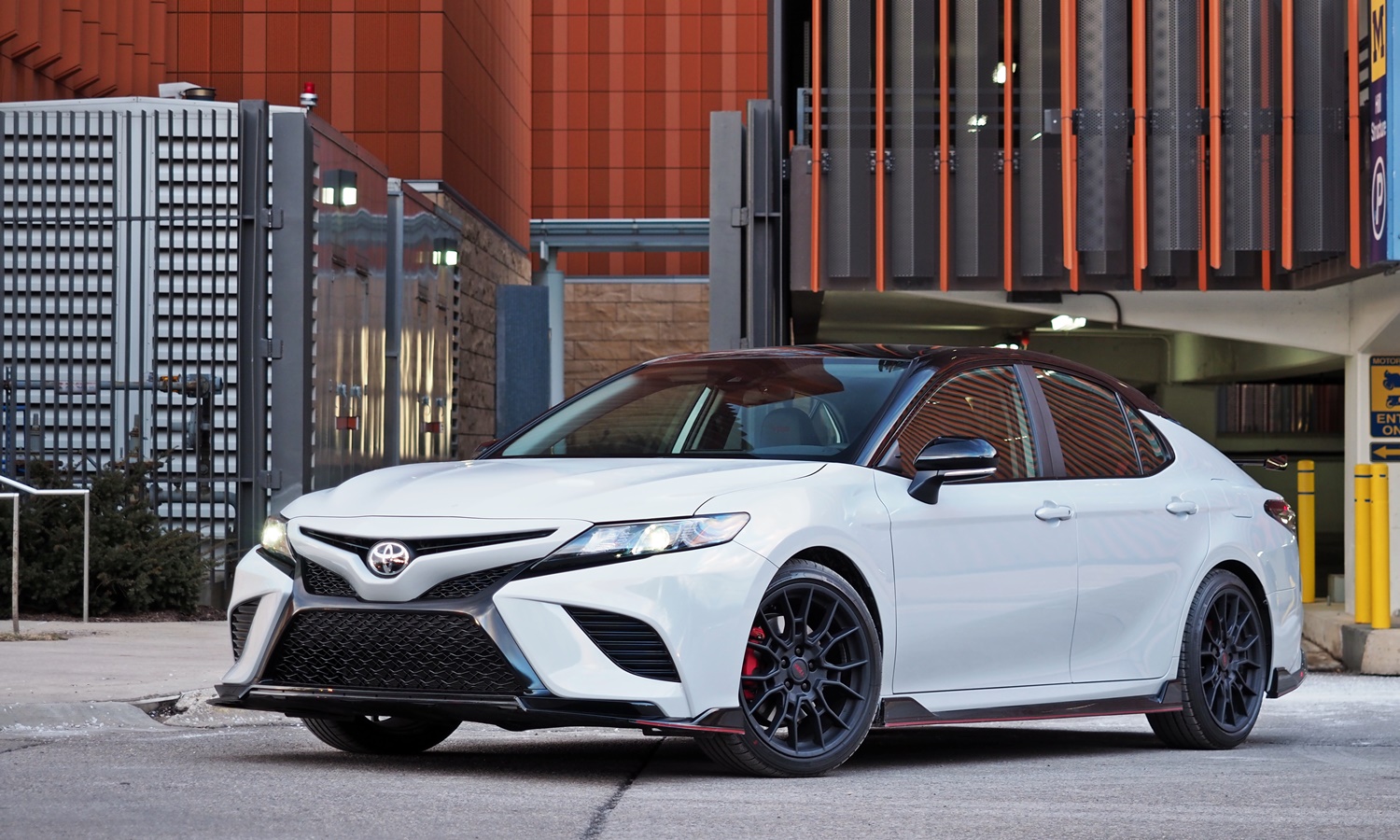
TRD adds a black body kit with a red pinstripes and lightweight thin-spoked matte black wheels. more Camry photos
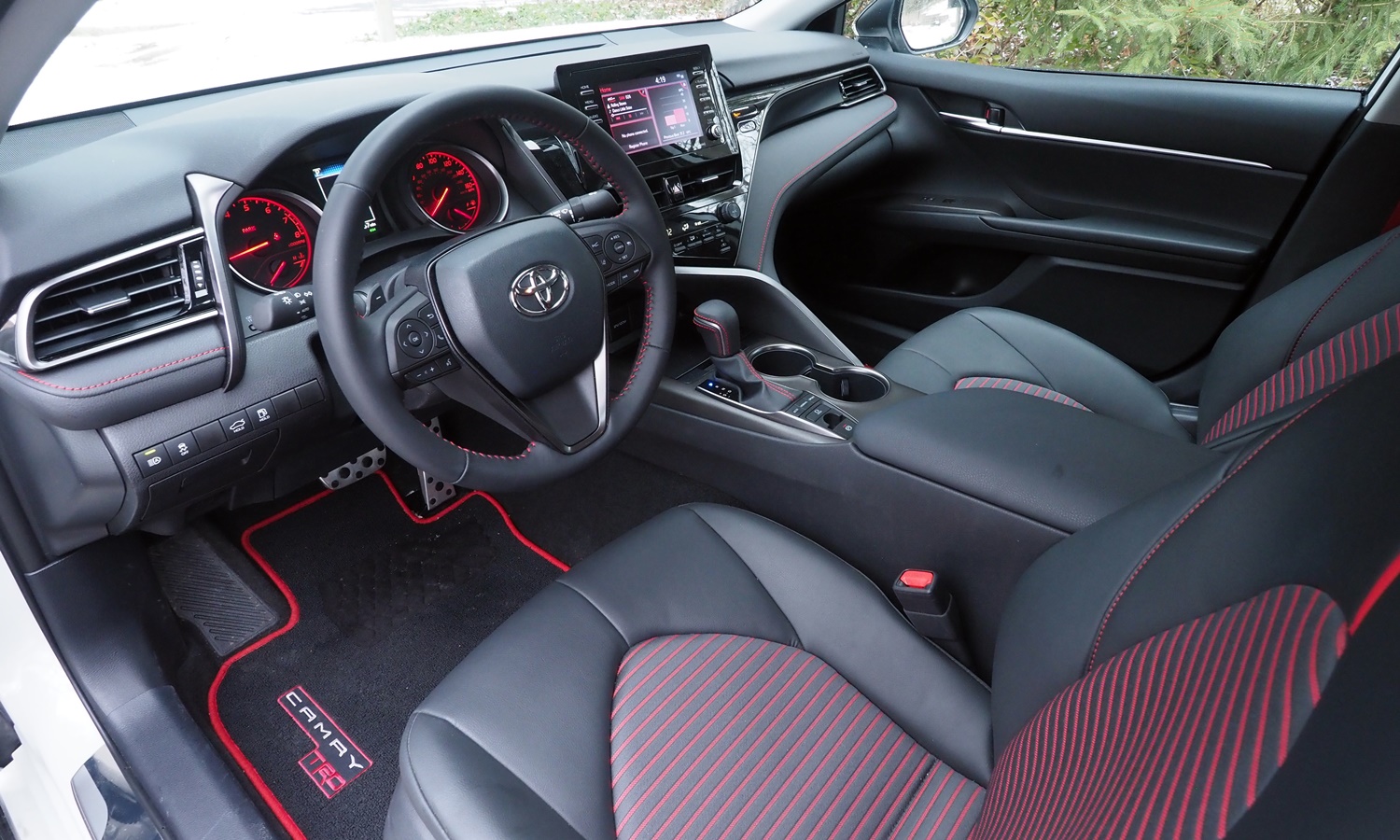
TRD adds red stitching, red stripes, and partial red lighting to an otherwise all-black interior.
| |
Compared to the Maxima |
| Exterior styling |
 Better
Worse
Better
Worse
|
Whether or not you like what Toyota's designers have wrought, you cannot deny that the Camry TRD's appearance is far from bland. For anyone seeking a midsize sedan with styling that screams SPORTY with no subtlety whatsoever, this is it. Whoever is in second--the Hyundai, the Kia, or the Nissan, definitely not the Mazda--it's not a close second.
The 2018 redesign gave all Camrys sportier lines, with muscular fenders, scalloped lower body sides, and rakish rear pillars. To this, the sport-trim SE and XSE (an SE with more luxury features, 19-inch instead of 18-inch wheels, and an available V6) add a menacing sci-fi face. And to this the TRD adds a red-pinstriped body kit, a pedestal rear spoiler, and lightweight thin-spoked wheels, all of them black.
The roof and mirrors are also black whether the color of the rest of the car is silver, white, or black. So if you find the high-contrast two-tone of the tested car too much on top of the rest of the TRD treatment, get black. This will also save you at least $500, which is the price of the contrasting roof color. White, since it's a pearlescent color that appears gray in low light, costs $425 more than silver and $925 more than black.
| Handling |
 Better
Worse
Better
Worse
|
The Camry TRD isn't just a styling package. TRD put real effort into upgrading and fine-tuning the springs, dampers, stabilizer bars, and brakes. They even added bracing to the body structure, with one unfortunate consequence: unlike in other Camrys, the rear seat cannot be folded to expand the trunk.
The benefits of these upgrades aren't readily apparent in typical daily driving, where the Camry feels somewhat large, insulated, and uninvolving. This is typical for front-wheel-drive midsize sedans. For such driving I generally find smaller, lighter cars considerably more engaging and enjoyable. But take the Camry TRD to a road where you can push it, and it wakes up. When the tires are given some work to do, the steering acquires an edge and communicates. Not a ton, but more than the steering in the average midsize sedan. Compared to any previous Camry the TRD feels noticeably tighter, more precise, and more balanced. The Camry TRD understeers so minimally that I wondered if brake-based torque vectoring was being employed to counter it. Apparently not. So the credit goes to TRD for its suspension tuning, which reduces body roll by 44 percent in the front and by an even larger amount, 67 percent, in the rear, and thus reduces understeer as well. On a more challenging road than can be found within a couple hours of my house, I could really enjoy driving this car.
It's been a while since I've driven any competitors. If memory serves, the Nissan Maxima had quicker steering and initial responses, but otherwise didn't feel all that sporty. The Ford Fusion sport felt about as capable, but not as tautly suspended and heavier (it was much heavier, 4,085 lbs. to the Camry TRD's not-light 3,575). The Ford did have all-wheel-drive so its throttle could be applied much more aggressively at low speeds and when turning. The Accord Sport felt very composed and predictable in the manner of an Audi, but partly because its steering was less communicative it wasn't as engaging as the Camry TRD when pressed.
Mazda didn't tune the Mazda6 Signature to have an overtly sporty character. Its aim was instead an outstanding balance between ride and handling and a driving experience that feels exceptionally fluid and natural. In this it succeeded, such that in typical daily driving I enjoyed the Mazda the most, and even on a race track I found it quite satisfying thanks to communicative steering--the best in the class--and intuitive handling. But would the Camry TRD be quicker around the track? Almost certainly, especially if shod with high-performance summer tires, a no-cost option not offered on the others. The Toyota also has a tighter, more aggressively tuned (if still far from hardcore) feel than the Mazda when exercised.
As noted in the intro, I haven't yet driven the new Sonata N-Line or the new K5 GT. One of these could be the most fun of the bunch.
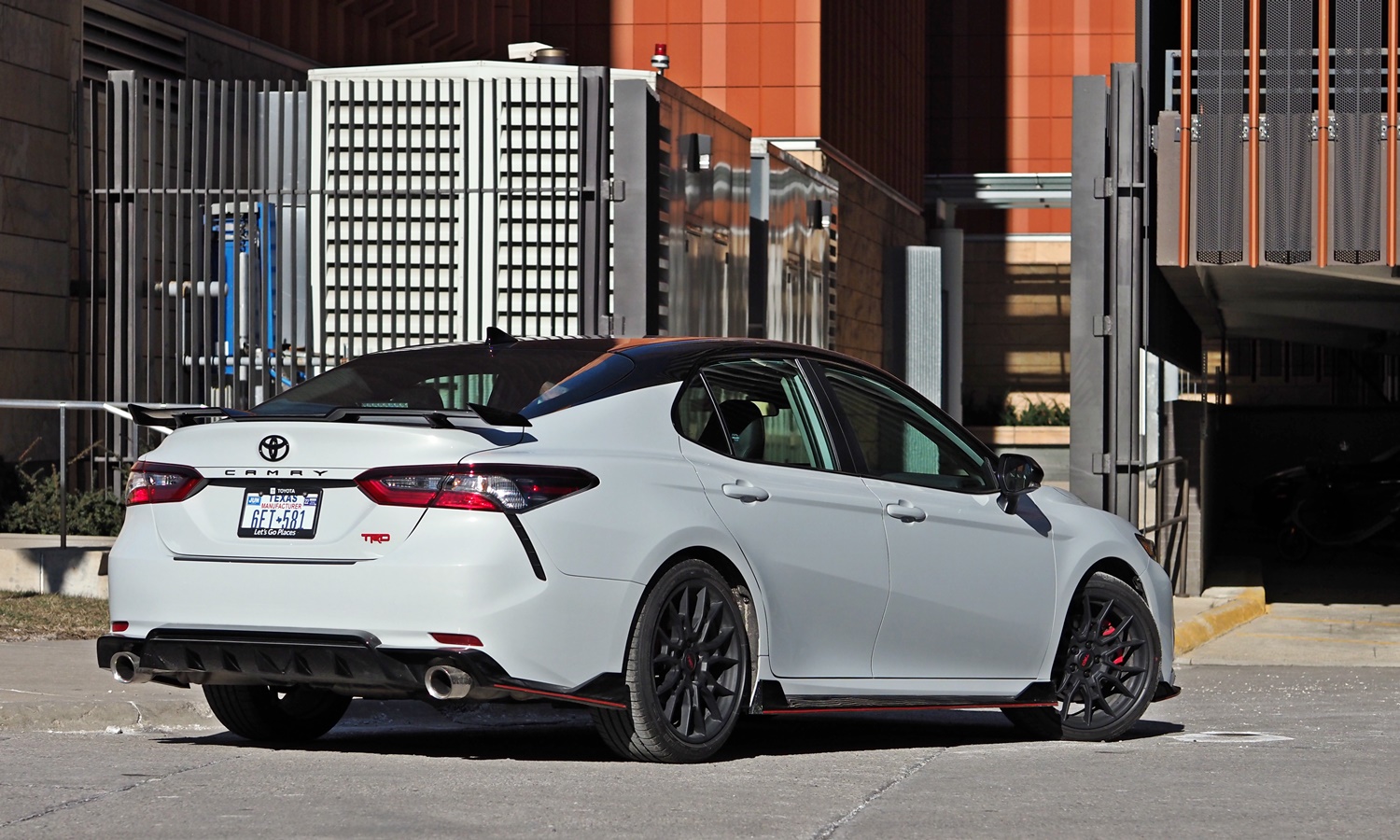
TRD also adds pedestal spoiler, black rear diffuser, and cat-back sport exhaust with big shiny tips.
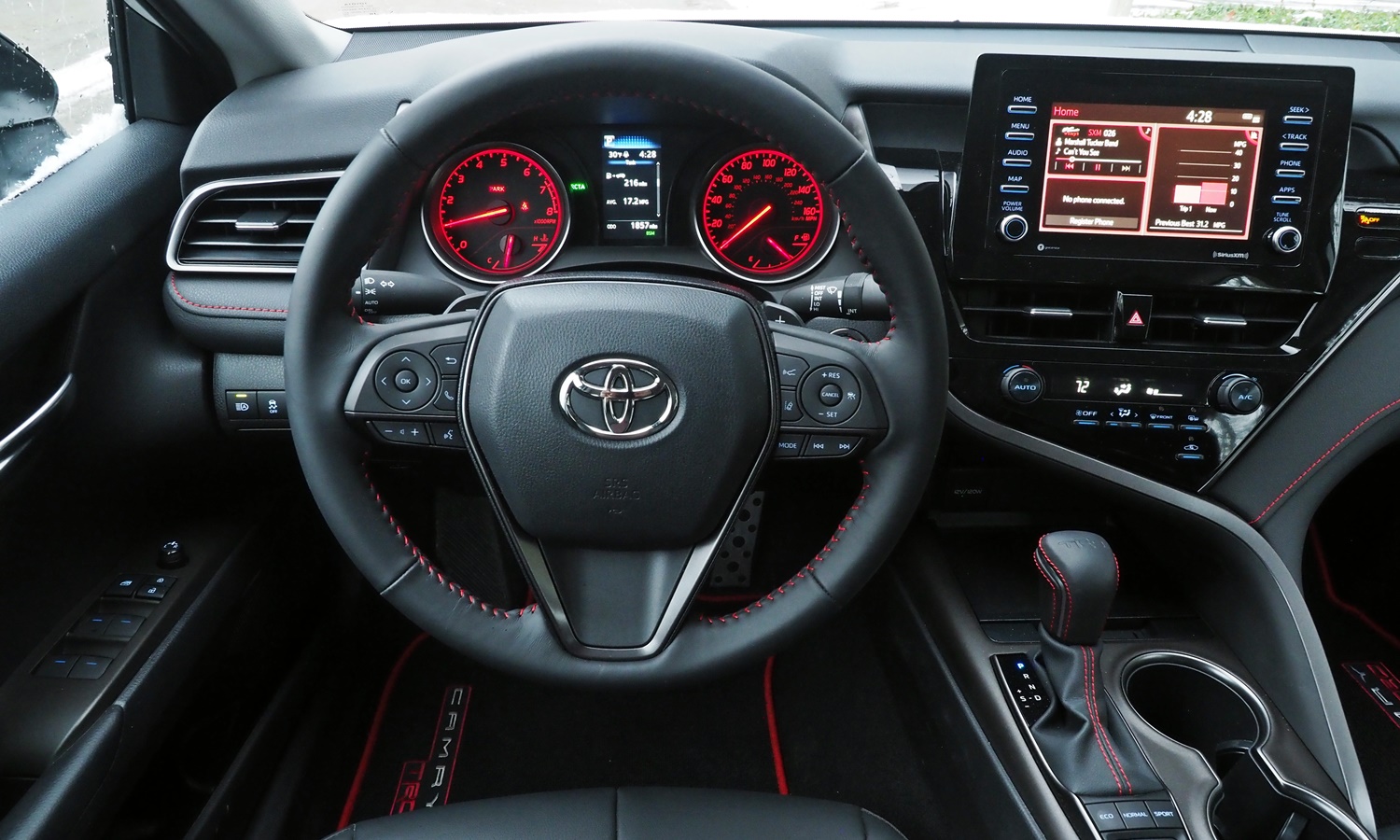
I admire the boldness and enjoy the overall theme, but too busy? Buttons retain blue lighting.
| Powertrain performance |
 Better
Worse
Better
Worse
|
With a relatively peaky naturally aspirated 301-horsepower V6 (the same as in other V6 Camrys) rather than a turbocharged four-cylinder engine, the Toyota Camry TRD is not the quickest car in the class. But for the great majority of drivers a 0-60 time around six seconds should be plenty quick. Twenty years ago only the quickest sedans were this quick, and they were powered by V8s. With the limitation imposed by front-wheel-drive, the Camry TRD's acceleration is traction-limited even without the midrange grunt of a turbocharged engine. Cracking the throttle wide open below 30 mph will dramatically shorten the lives of the front tires. A limited-slip differential like those employed in high-performance Civics (but not any Accord) would help.
But the above isn't why I've put "powertrain performance" in the "why to buy" section. Test track times aren't everything. A well-tuned V6 sounds and feels better that a boosted four. And if you want a well-tuned V6 in this class, the Camry has become your only option. For another $10k you can get a Nissan Maxima, but I prefer the sound and feel of the Toyota engine even before considering the transmission each is paired with.
Consider transmissions, and the contest between the V6 sedans isn't even close. The Maxima has a CVT, which though better-behaved than the average CVT can still do some unnatural feeling and sounding things with engine speed. The Camry TRD has an eight-speed automatic tramsmission which shifts very smoothly and generally doesn't call attention to itself (though the more open TRD exhaust makes shifts evident), but which could be more responsive in aggressive driving. On curvy roads I often used the paddles to manually shift. They worked well.
| Reliability & durability |
 Better
Worse
Better
Worse
|
Reliability warrants inclusion in any list of reasons to buy a Toyota Camry. Though the great majority of cars have become more reliable, such that they require few if any repairs during their first four-to-six years, if you want a car that will remain relatively trouble-free for more than a decade a Toyota remains the way to go, with a Honda the second-best but relatively iffy choice.
The high priority Toyota puts on reliability led them to fit the Camry's V6 with both direct and port fuel injectors. Direct injectors are best for performance and fuel economy, but port injectors better prevent carbon build-up on the valves. An engine with both has the benefits of both.
| Price or payments |
 Better
Worse
Better
Worse
|
With a base price of $33,180, the Toyota Camry TRD isn't cheap. (Add $925 for the black roof and pearlescent white paint on the tested car.) But it is less expensive than every alternative save the $32,865 Honda Accord Sport 2.0T and the $31,455 Kia K5 GT, which in tuning and appearance line up more against the less overtly sporty Camry XSE V6. No eye-grabbing body kit. No spoiler. No sport exhaust. No high-performance suspension. No high-performance summer tires. And the Camry XSE V6? It lists for $36,540.
| |
Compared to the Maxima |
| Feature availability |
 Better
Worse
Better
Worse
|
So with the Camry TRD you get a slew of tuner-class appearance and chassis bits, yet it costs less than most alternatives and the Camry XSE even though the others have no such bits? What's the catch?
The catch is that if you want luxury features you cannot have them, not even as options. Okay, you can get a JBL audio system for $1,545, but that's it. The cheap-looking cloth on the TRD seats? Mandatory. Illuminated vanity mirrors like those standard on even the cheapest Accord? Toyota continues to package those with a sunroof, which isn't offered on the TRD. (One is standard on the Accord Sport 2.0T, a con for people who don't want a sunroof.) Nav? Nope. Do you require heated seats? Though these are standard on most competitors, with the Camry TRD you'll have to resort to the aftermarket for bun warmers. Also, as already mentioned, exterior color choices are limited to all-black, silver with a black roof, and white with a black roof. If you'd like a color such as blue or red, you'll have to get a non-TRD Camry or a competitor.
If you want a manual transmission, well, neither the Camry TRD nor any direct competitor still offers one. Honda offered a manual with both Accord Sport engines through 2020, but not for 2021. Apparently not enough people bought one. All-wheel-drive is offered on both the Camry and the Nissan Altima, but only with sub-200-horse four-cylinder engines. AWD would greatly improve low-speed traction in the Camry TRD. If you want a quick midsize AWD sedan with a price in the 30s, visit your Subaru dealer. But you'll no longer find a Legacy GT there, and even when you still could it wasn't all that sporty.
Toyota's package of collision prevention systems and driving aids, including full-range adaptive cruise control and automatic high beams, is included.
Toyota's "lane tracing system" is supposed to be able to keep the car centered in a well-marked lane, and I tapped the button to select "lane centering," but in neither this car nor a Highlander I tested two weeks later did this system keep the car centered.
| Interior styling |
 Better
Worse
Better
Worse
|
Toyota gave all current Camrys a sportier interior. The way both sides of the instrument panel flow diagonally into the center stack is creative and distinctive, but also somewhat busy and forced. Nearly every detail by itself seems a good idea, but there are just too many of them. Also, too much hard plastic calls attention to itself, most notably in the S across the center stack. Just about any competitor has an interior that appears more upscale, refined, and stylish. Even the cheapest Mazda6 is in a whole other league. The Mazda6 Signature is in a whole other league from the base model.
TRD's tweaks include plentiful red stitching, red seatbelts, and seats with red striped center panels and "TRD" embroidered on the headrests. The seats in particular, well, if you like how the car's exterior looks you might like how these seats look. Or not. The exterior might look overly showy, but it doesn't look cheap. These seats look cheap.
Another TRD tweak: red instrument lighting. But the information center between the instruments remains white and the lighting for the various buttons remains blue. Three colors is at least one too many, and likely two too many.
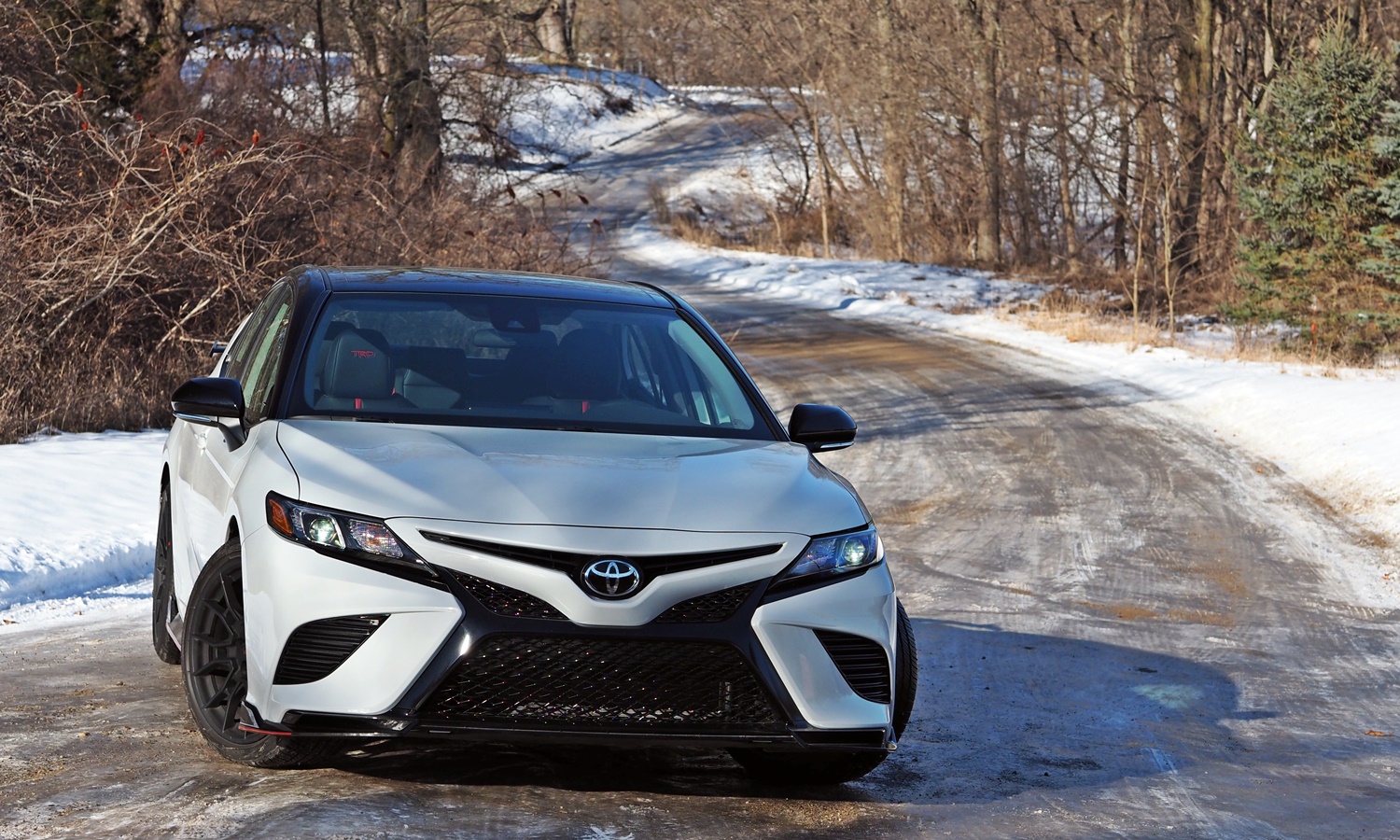
Summer tires are a no-cost option, but you wouldn't want them on a road like this.
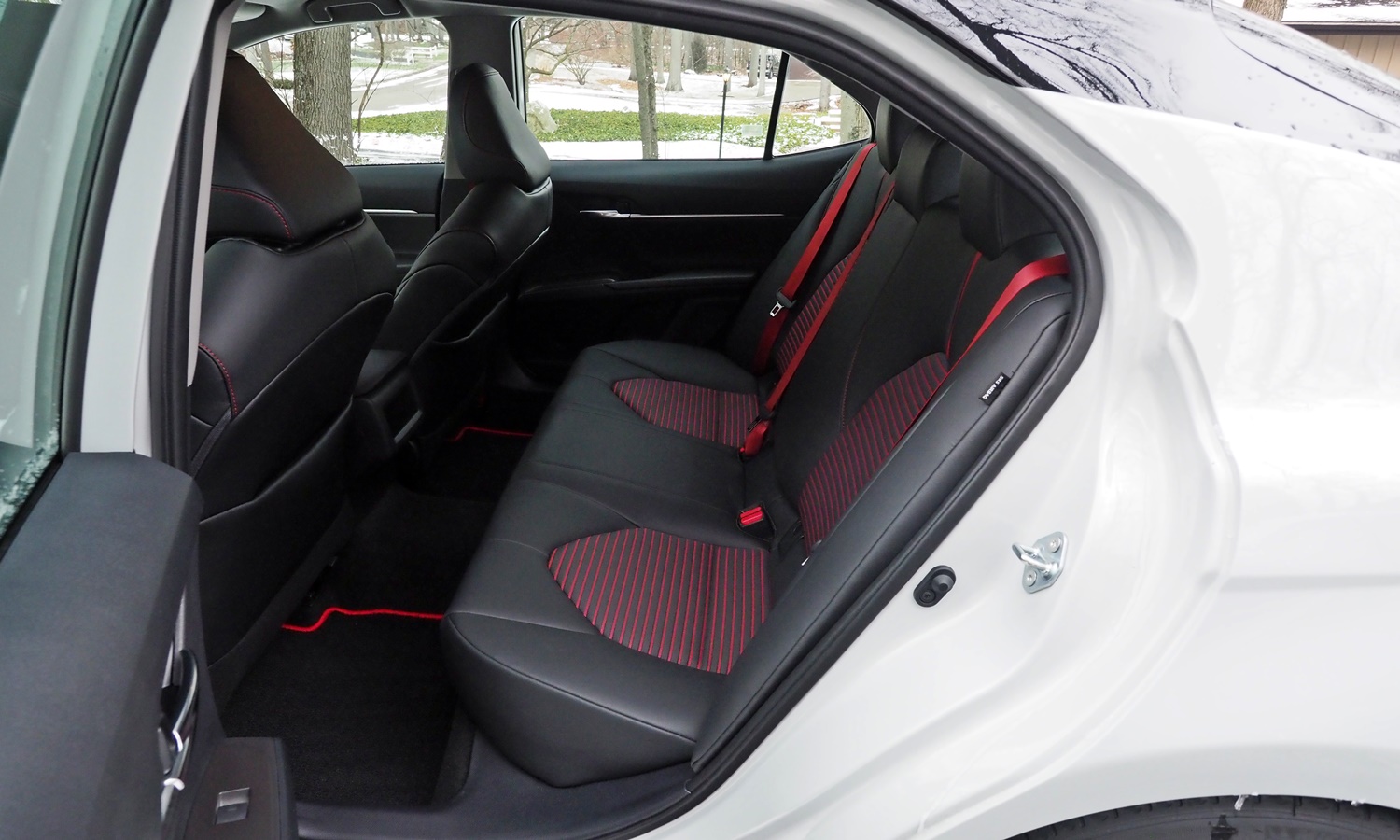
Little thigh support, marginal headroom. The price of the sporty roof line.
| Front seat support & comfort |
 Better
Worse
Better
Worse
|
The seats might be forgiven for how they look if they provided good support, both lateral and in general. They don't. They're not bad seats, but they're short on padding and contour. A pair of properly styled and shaped seats would do much for perceptions of the whole car.
And, in case you missed it in the feature availability section, no bun warmers.
| Rear seat room & comfort |
 Better
Worse
Better
Worse
|
The rear seat is similarly meh. Passengers back there will encounter a decent amount of legroom (much more than in the Mazda6), but (unless they have very short legs) insufficient thigh support and (if they're of above-average height) the headliner. This last is the price of the current Camry's racier roof line. Perhaps they figure people who require a roomy rear seat will buy a crossover. To be fair, many manufacturers have been sacrificing rear seat headroom for a more stylish roof line, as this seems the best way for sedans to retain appeal in a market hot for crossovers.
| Cargo capacity |
 Better
Worse
Better
Worse
|
As mentioned back in the handling section. TRD added bracing between the rear seat and the trunk, so unlike in other Camrys and in any direct competitor the Camry TRD's rear seat cannot be folded to expand the trunk. The trunk itself is competitive in size.
| |
Compared to the Maxima |
| Ride smoothness |
|
You might have noticed that we made it all the way through the reasons not to buy a Camry TRD without mentioning ride quality. All too often in the past "sport suspensions" have ridden harshly. Well, not the Camry TRD's suspension. The springs are definitely firm and the dampers are definitely tight, but they deliver a livable ride even over poorly maintained pavement. It likely helps that TRD reinforced the body structure. Overall, they achieved an impressive balance between ride and handling.
Noise levels are low enough (if not quite premium sedan low) that the Camry TRD doesn't feel as quick as it is. The exception: the TRD exhaust. When cruising on the highway it drones a bit. Plus if and when the transmission opts to wander among its ratios the exhaust announces each shift. Not obnoxiously, but if not for the changing exhaust note the transmission's shifts in casual driving would often be undetectable.
| Controls and instruments |
 Better
Worse
Better
Worse
|
If I'd had another "reason to buy" slot, I'd have put the Camry's controls in it. Four large knobs and plenty of non-virtual buttons are located high up within easy reach.
| Fuel economy |
 Better
Worse
Better
Worse
|
Other manufacturers have been replacing V6 engines with turbocharged fours and conventional automatics with CVTS and automated dual-clutch manual transmissions (DCTs) to improve fuel economy. With EPA ratings of 22 city and 31 highway, the Camry TRD trails the Honda Accord Sport 2.0T (with a ten-speed rather than an eight-speed automatic) by...one mpg on the highway and none in the city. The Hyundai Sonata N-Line, with a 2.5T engine and an eight-speed DCT does a single mpg better in the city and two mpg better on the highway. The Nissan Maxima, with a V6 and a CVT, does two mpg worse in the city and one worse on the highway.
Based on their EPA ratings, fuel economy isn't a reason to choose any of these cars over the others, with the possible exception of the Maxima. The alleged advantage of the turbo fours and the unconventional transmissions isn't evident.
In the end, I'm of two minds about the Toyota Camry TRD.
First, wow. If someone had told me back in 1983, when Toyota introduced the Camry as a 92-horsepower, 2,400-lb., 176-inch-long, softly suspended, intentionally bland sedan, that a 2021 Camry would be the 301-horsepower, 3,600-lb, 192-inch-long, firmly suspended, intentionally in-your-face car you see here...I simply would not have believed them. Back then it was a BIG DEAL when a V8 squeezed out 200 horsepower. 300? Only exotics with twelve-cylinders had that.
And yet, as much as I admire TRD's work here, their wild styling suggests the midsize sedan equivalent of Honda's Civic Type-R, but the Camry TRD doesn't drive remotely like a Civic Type-R. It's too large, which increases the power needed for serious thrills beyond the limits of front-wheel-drive. Its transmission is a good but not terribly responsive automatic, not an engaging slick-shifting manual (or even a DCT). Its steering, though precise and somewhat communicative in hard turns, does not feel razor-sharp or respond RIGHT NOW. And its suspension, though more aggressively tuned than that of any previous Camry, remains relaxed enough to also deliver a livable ride. To really move the needle on the Camry's non-sporty image, TRD needed to turn the tuning up to eleven (as they did with the styling), or at least ten. Instead, they turned it up to eight.
Oh, and the car has no seat heaters.
But I'm pretty extreme in my desire for consistency. You might want a midsize sedan that looks exciting, and that feels sporty and capable when driven hard along a twisty two-lane road, but that can relax (and let you relax) in typical daily driving. You might need it to be affordable, both when you buy it and ten-plus years down the road. If so, the Toyota Camry TRD could well be the car for you.
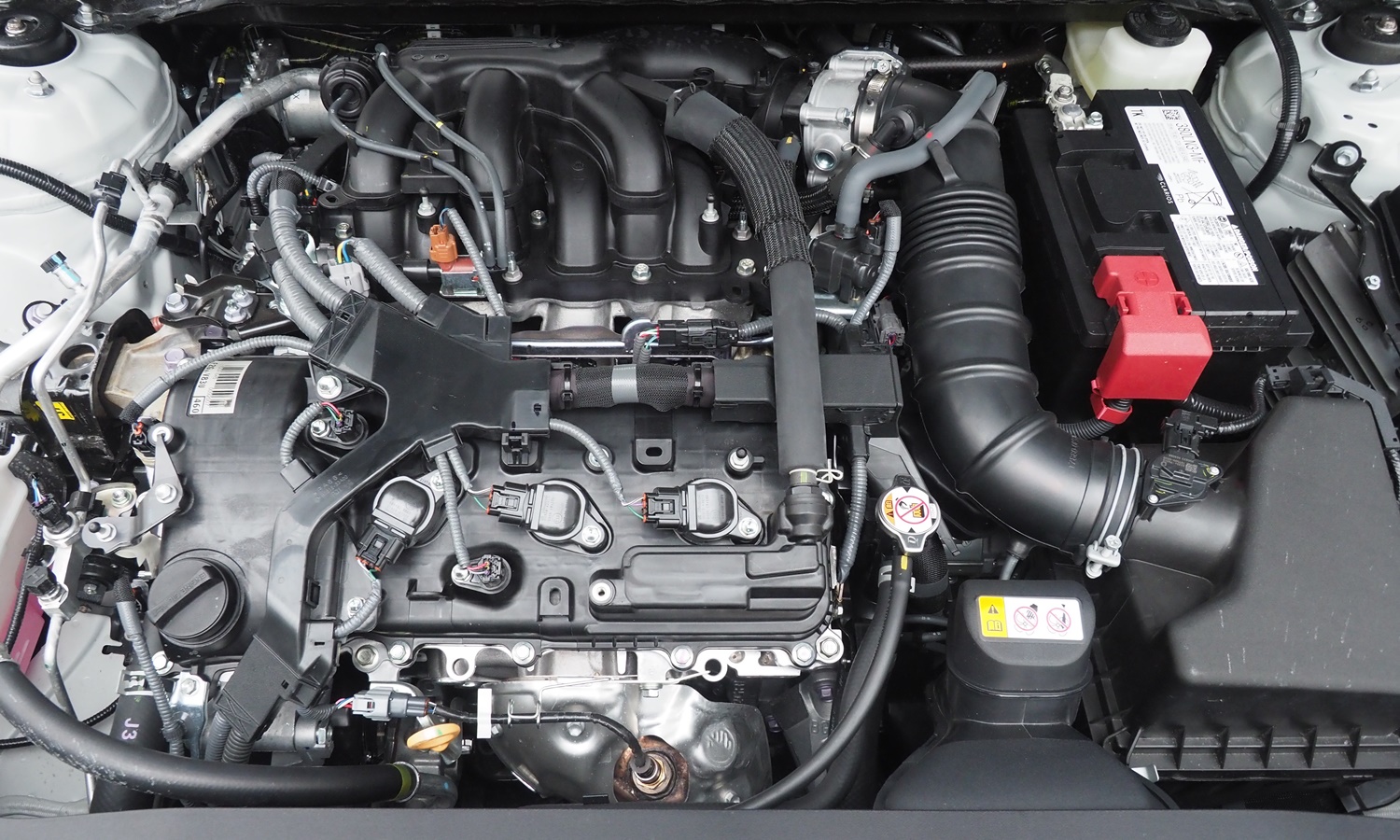
Excellent V6. Two sets of injectors, port and direct, for the advantages of both.
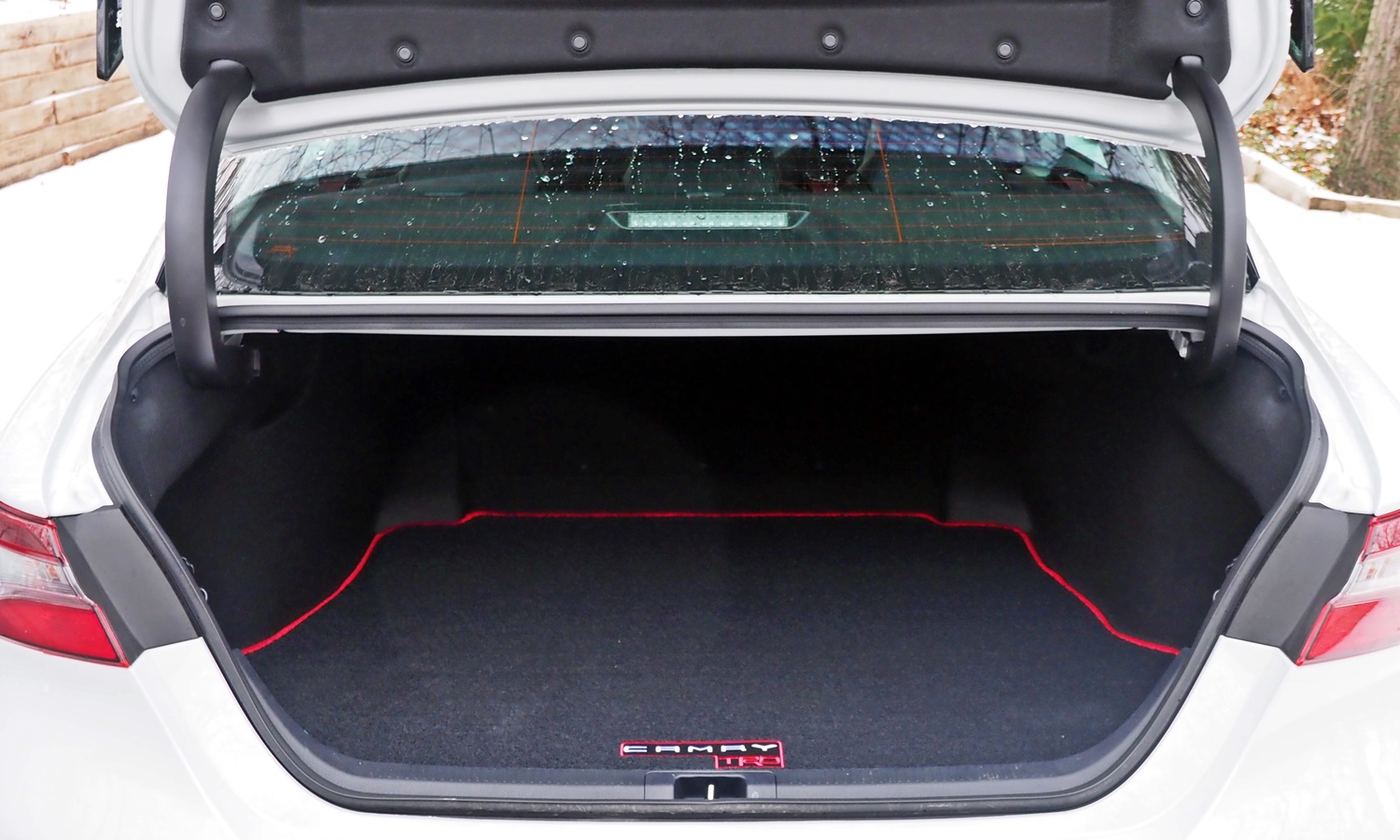
Because of extra bracing added by TRD, the rear seat does not fold.
See more 2021 Toyota Camry photos
Toyota provided an insured car with a full tank of gas for a week.











